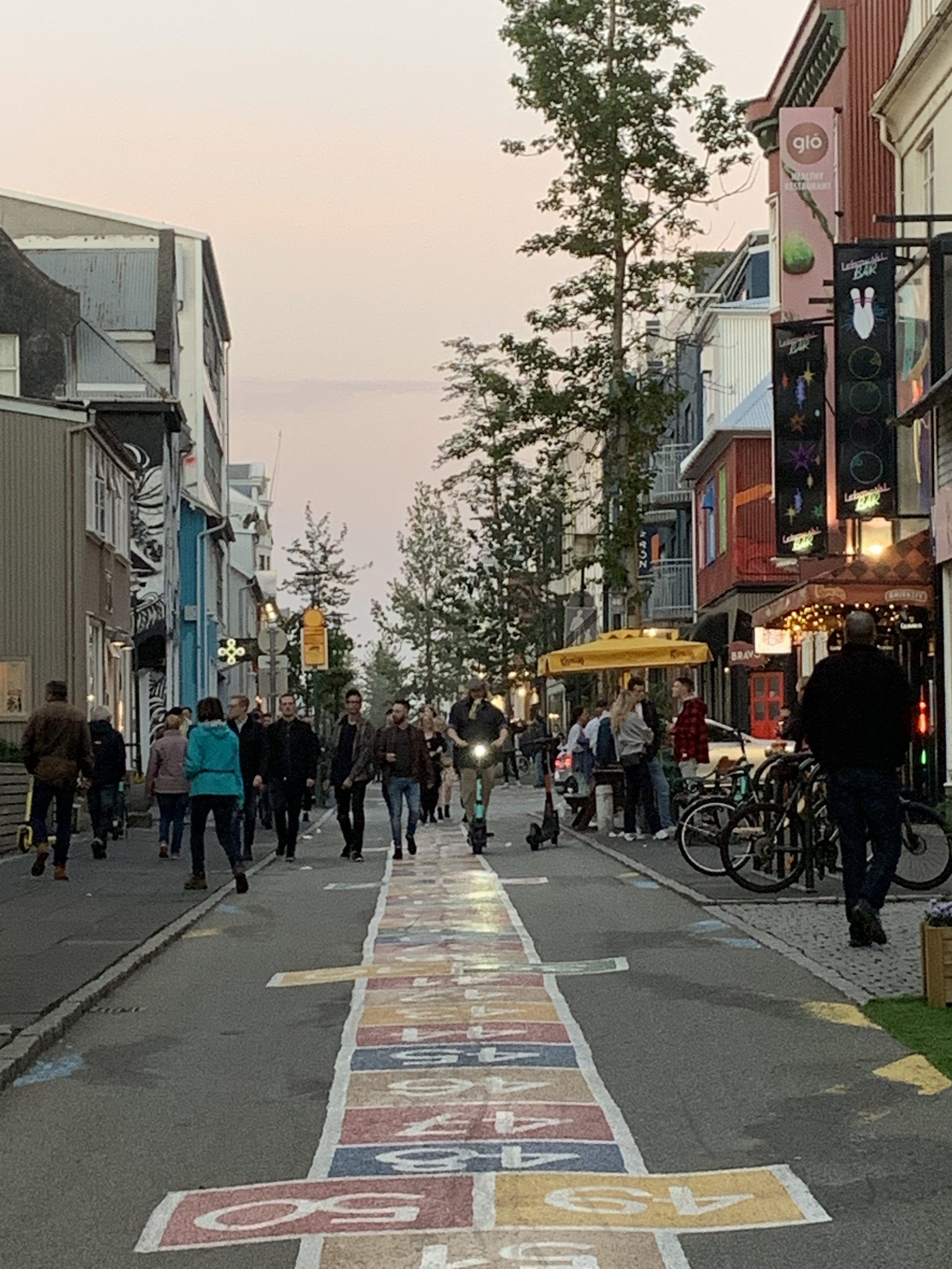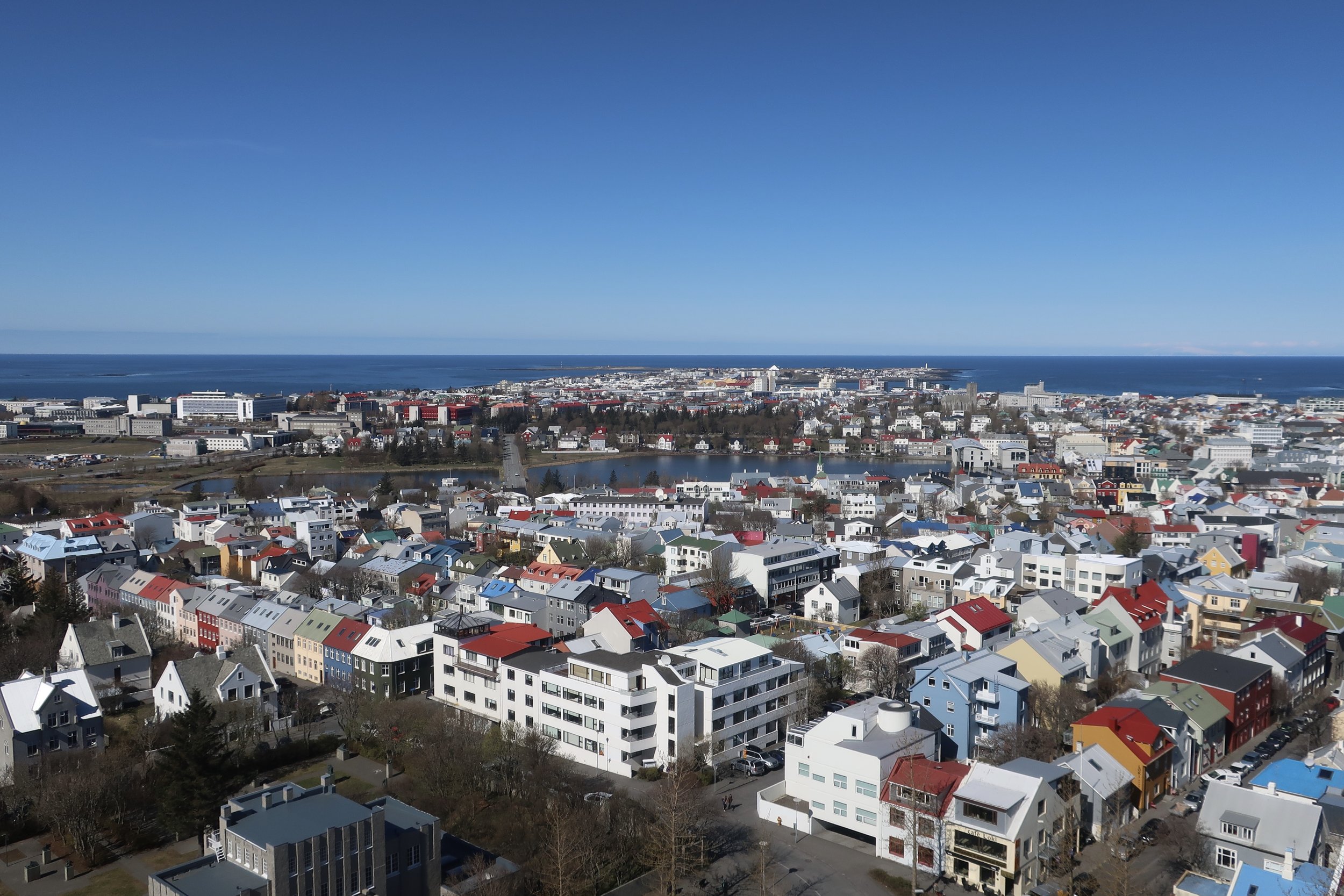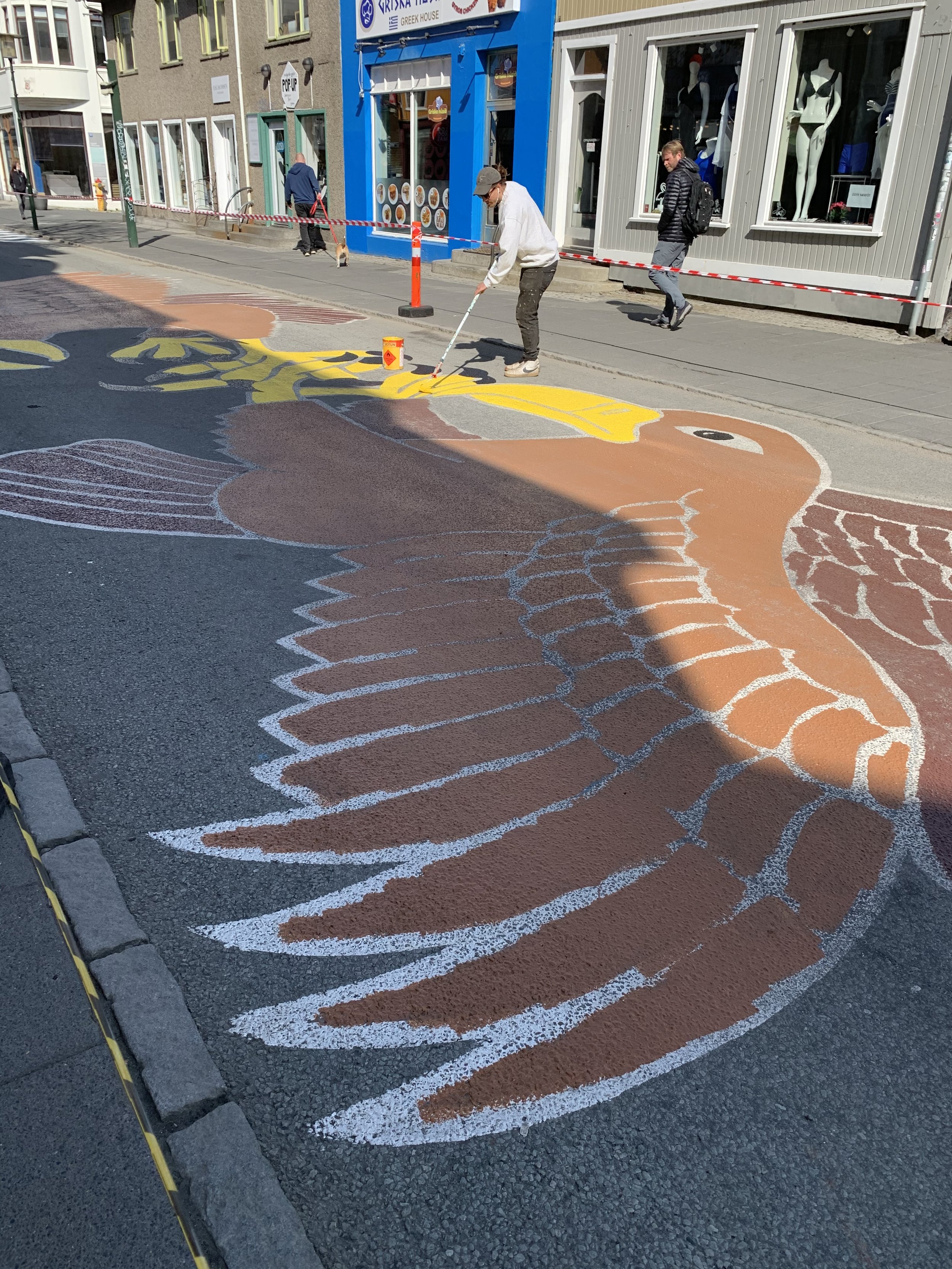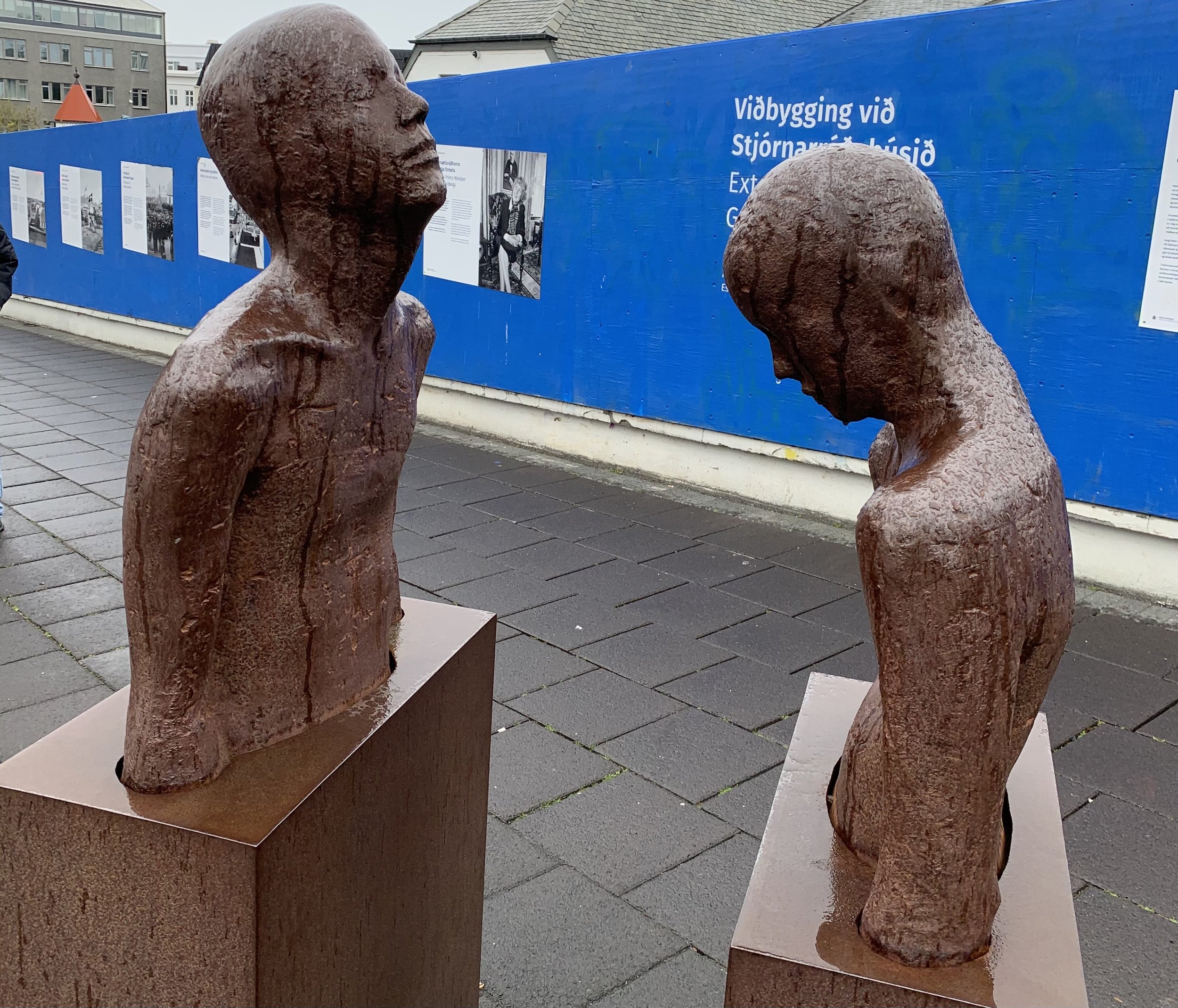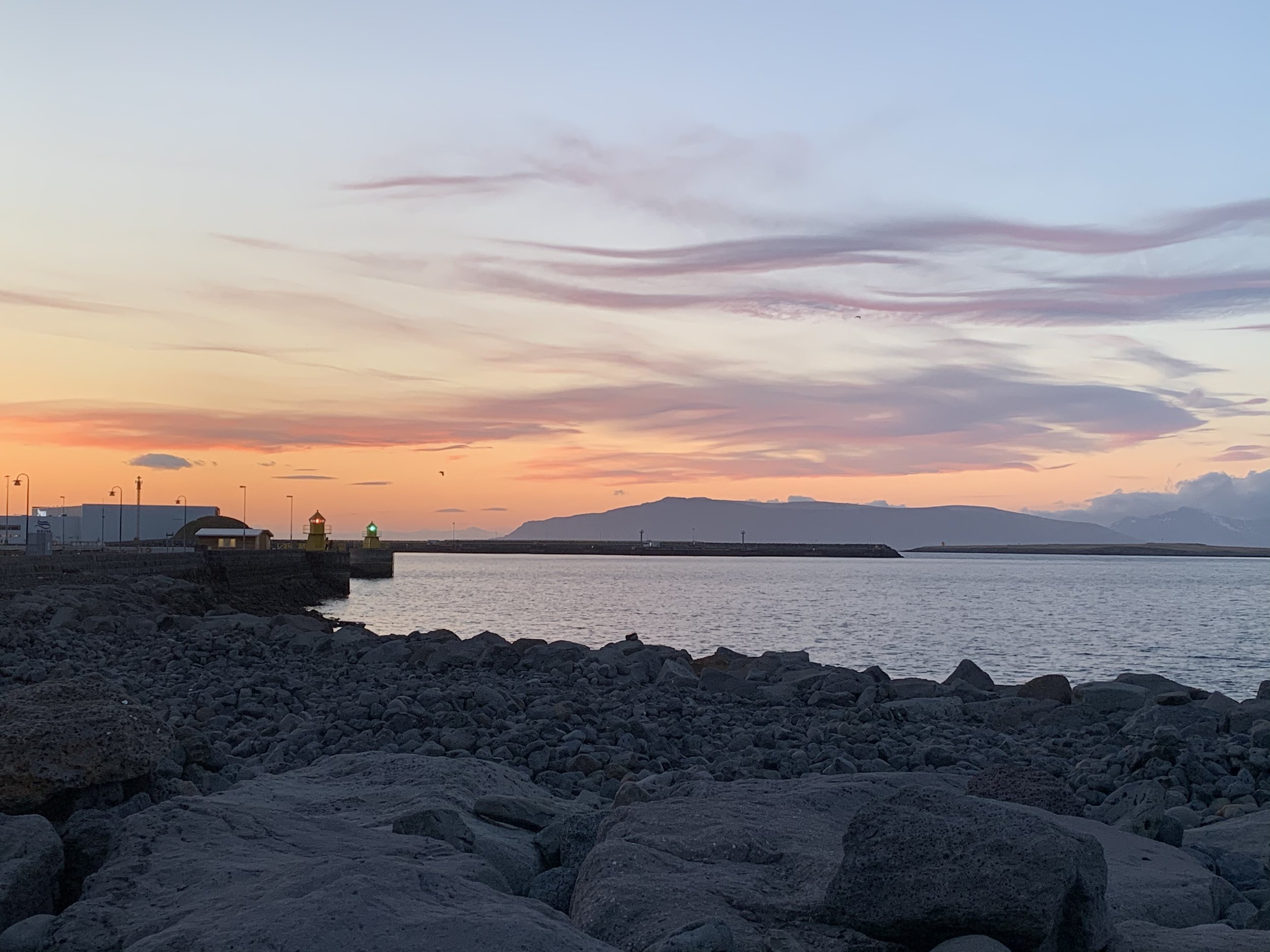Reykjavík Life
Reykjavík is, of course, the capital city of Iceland, which means that, at a latitude of 64 degrees, just two degrees south of the Arctic Circle, it is the northernmost capital of the world! Nearly two-thirds of the population of Iceland lives in the capital area. To be fair, that is only around 123,000 people (around 20,000 fewer than live in Guildford, and a similar number to the inhabitants of Gateshead in the North East), but it’s still by a long long way the most populated area of Iceland. And what it may lack in numbers it more than makes up for in culture, nightlife and excitement.
Part of Reykjavík with the Flaxaflói bay and Mount Esja beyond
A few facts and a little history
I found a few interesting facts about Reykjavík when I was first looking up information about living in Iceland.
Reykjavík is the northernmost capital of a sovereign state in the world.
It is among the cleanest, greenest, and safest cities in the world.
The first permanent settlement in Iceland was in Reykjavík in 874 AD.
The word Reykjavík translates literally as “smoky bay”. The name refers to the steam that used to rise from the hot springs and geothermal vents.
64% of all Icelanders live in the capital area.
Reykjavík is the only Western European capital without a Starbucks or a McDonald’s.
Reykjavík is the only capital city in the world that is home to a puffin colony.
Dogs were banned in Reykjavík from 1924 to 1984.
As a consequence of the dog ban, Reykjavík is still a mostly cat city.
There is a penis museum in Reykjavík called the Icelandic Phallological Museum.
During WWII there was a huge demand for sources of fish among the fighting nations. Because of its strategic location in the mid-Atlantic Britain invaded Iceland in 1940, helping to protect its fisheries, and then the United States took over this protective occupation in 1941.
Reykjavik has grown rapidly since WWII. It was only when the war ended that Iceland declared its complete independence from Denmark and from that point on, Reykjavík became the capital city of this newly independent country.
Another birds-eye view of the city
After the war, some US troops remained in Iceland. They wanted to eat, drink, have cultural events and be entertained… this had a huge social impact on the locals who started to want to extend their social lives as well. Because of this, Reykjavík grew and developed, opening bars and restaurants and investing in sports and the arts.
A once simple village rapidly became a modern city. In the last few years, cultural interest in Iceland has grown rapidly and Reykjavík was chosen as one of the European Cities of Culture and one of the UNESCO Cities of Literature.
Reykjavík has two airports; Reykjavík Domestic Airport which is within the city itself and Keflavík International Airport, where international visitors will arrive. This is some 45 minutes from the centre of Reykjavík itself and welcomes over 1.5 million visitors a year – about 5 times the nation’s population.
A view of the sea wall looking back from the harbour
So…. What’s it like to live here?
Reykjavík is a wonderful city to live in! For someone who has always hated the idea of living in a city, I find I have grown to love the vibrant bustle of apartment living in a (small) city.
The town centre of Reykjavík is relatively small – you can easily explore it in half a day or so. The main shopping street is Laugavegur – full of boutiques, tourist shops, bars and restaurants. It is one of the oldest streets in Reykjavík and is at the heart of downtown Reykjavík. There are many small streets run off Laugavegur (one of which is where we live, so we are just a few steps away from everything that is going on in the city).
Laugavegur at night
I think what makes it so nice to live here is that the section of Laugavegur that we live off is pedestrianised, so there is little traffic and just the bustle of people taking photographs of the street art that is everywhere you look, or spilling out of the cafés and restaurants. Tables get dragged out onto the street and, particularly in the summer, the atmosphere walking along the street is of one big party. In fact, Reykjavík does feel like a party town!
Reykjavik cafe culture
.
The other best known street in Reykjavík stretches up from Laugavegur to the huge church of Hallgrímskirkja and is called Skólavörðustígur – although most people just call it rainbow street due to the bright colours of the street painting. Quirky, trendy and very popular, there will always be visitors taking photos and enjoying the cool shops and coffee bars.
Skólavörðustígur or Rainbow Street
Although there are a number of churches in the capital, Hallgrímskirkja dominates the area, being situated just off the centre of downtown Reykjavík and a few minutes walk from the main shopping area. It is one of the most iconic and instantly recognisable buildings in the whole of Iceland and often features as a sort of unofficial symbol of the capital city. You can see the spire from just about anywhere in the city and when I was first living and working here I learned very quickly not to be stressed or anxious about losing my way when driving – which can be a little daunting at first in a new city – because the spire of Hallgrímskirkja would almost always be visible, set as it is on a small hill, and if I just headed in that direction I could easily find my way back to our apartment.
Hallgrímskirkja towering over the surrounding buildings
Talking of Hallgrímskirkja – as well as being lovely to visit in its own right, with a wonderful sense of peace and calm, even when full of visitors, it is also possible to go up to the top of the huge spire and get wonderful views right across the city. The architecture of the church itself is stunning, dwarfing you as you stand in front of it. Simple and almost like something from Lord of the Rings in appearance, you soon realise the design of it resembles the hexagonal volcanic basalt lava columns that appear in so many places in Iceland and that, although stark and uncompromisingly modern, the church reminds you of some of the oldest natural rock structures in this amazing country.
Looking down onto the residential area of Reykjavík from the top of Hallgrímskirkja
One of the things I love about living here is that although it is the capital city it has such a villagey feel. It is uncommon to go for a wander through the streets, or just head off to the local supermarket without meeting someone you know. Some Saturday mornings I’ll encounter three or four people I know from work or people I have met out here since living here. I suppose it’s not so surprising as the city is really very small indeed, but it feels rather nice.
Reykjavík is a very colourful city, with designs painted on the pedestrian areas of road, and street art on many houses, across the city, much of it quite stunning. I love the bright colours and the fact that you don’t know what you will come across as you come round the next corner. It’s always worth looking upwards as well as around you when walking around here as you never know what you will see. I love watching the surprise on people’s faces as they turn a corner and see a house, covered from top to bottom in intricate designs.
Talking of surprised tourists, one of the things that always makes me smile is heading out early in the morning to go and get bread from the bakery or just to have a wander. What many people don’t realise, particularly when they first come out here is that the opening hours in Iceland are very different to most other places – and particularly here in Reykjavík to most other capital cities. Most of the shops on Laugavegur do not open until 11am and are then open until 6pm. Some of the tiny independent shops may not open until 12 noon – and then only if the proprietor feels like it! Even the large out of town shopping centres tend to keep 11-6 or 7pm opening hours. So an early morning walk through the city will still be busy because the tourists are out exploring, but they often are walking with an air of bemusement because it may be 10am and nothing whatsoever seems to be open!! There are of course some cafés and bakeries that keep earlier hours and offer a welcome coffee and Danish pastry breakfast, but they take some hunting down and the sense can be of a city that is still fast asleep! The same applies across Iceland and we have learned when going on road trips, not to expect to be able to stop for an early morning coffee or for breakfast, because in the smaller towns and villages there may well be nothing on offer. We now plan accordingly and take supplies and the discovery of an open bakery, serving early morning coffee is a source of great excitement and rejoicing!!
Lake Tjörnin with many of its feathered inhabitants
Right in the heart of the city but feeling totally unlike city life!
One of the most colourful and attractive areas of the city (to me) is reached by walking down the hill towards the older part of the city where there is a lovely lake called Tjörnin (which means ‘the pond’). With the City Hall set on its banks and a path all the way round it is one of the locals’ favourite spots to walk. It is also home to ducks, swans, geese and all sorts of other birds (according to the internet, some 40-50 bird species gather there) and in the summer the noise from them can be quite deafening! The houses around this area are older and very attractive, painted many colours and it is a lovely place to go for a walk and admire the different homes, many of them made of corrugated iron or wood, looking like sweet little Hansel and Gretel homes. I love the fact that the homes are all painted different colours. I heard someone say that Reykjavík looks like a city that a 7-year old with a huge box of crayons would draw!!
I mentioned culture, and it is visible everywhere you walk here. The Icelanders are incredibly cultured people. Great readers and lovers of poetry, apparently more books are published in Iceland per head of population than in any other country, and they are of the highest quality. Although very expensive, books sell in huge quantities here. One in ten people here will publish a book in their lifetime!!! One of their favourite mediums is poetry, and many Icelanders write poetry. When I first came out I read a short book about the Icelandic people and culture, which said “It is rumoured that one day Reykjavík will be adorned by a new statue raised in memory of the lone Icelander who never wrote a poem”.
The visual arts too are close to the hearts of all Icelanders. Many people sculpt or pain in their spare time, and it is often said that the creativity of the Icelandic landscape is reflected in the creativity of the people. This love of painting and sculpture can be seen everywhere in Reykjavík, both in the sculptures and statues that appear everywhere across the city and in fact across the entire country, and in the number of shops that are in the high street, selling painting, sculptures, pottery, and other arts and crafts. I have never been anywhere where there are so many art galleries, art shops and pop-up installations, ranging from traditional, to abstract to the downright weird! New pop-up galleries appear regularly and to much local and tourist interest.
And music and theatre don’t take a back seat either; one of the great sights of the city is the Harpa Concert Hall, a huge contemporary glass and steel building next to the harbour, offering year-round cultural events, daily exhibitions in the summer and everything from classical concerts and opera to films, poetry readings, traditional Icelandic folk songs and comedy shows.
Harpa Concert Hall
And there are museums everywhere. Again, I have never been anywhere where they seem to love museums like in Iceland. I remember one road trip where we came across a little hamlet in the middle of absolutely nowhere, with barely a shop or bar, but with plenty of signposts pointing the way to the local museum. There are museums for everything; Viking museums, maritime museums, museums of architecture, whaling, farming, costumes and textiles…. We even came across a signpost for the Museum of Everyday Life!!!!
Reykjavík is, of course, a harbour town overlooking the bay of Faxaflói. One of our favourite places to wander in the evenings is down to the harbour wall and around the bay, looking at the many sculptures – particularly the stunning Sun Voyager – and watching the lights of the city and Harpa Concert Hall reflected in the water. We have been lucky enough to see seals playing in the water of the harbour as we’ve walked and apparently people have seen whales and porpoises too, although we never have this far inland. Again, whenever – day or night – you wander along the harbour path, you will meet others doing the same thing and pass the time of day.
Looking past the concert hall to the harbour beyond
If you walk on, past the Harpa Concert Hall to the old harbour itself there are stunning views across the bay and the docked sailing boats, to the landscape beyond. Most impressive is the huge, flat-topped mountain Esja – apparently the most popular hiking spot in the country and often wreathed in cloud. Esja seems to be snow-covered for much of the winter and makes a glorious backdrop to Reykjavík and Faxaflói bay at any time of the year.
Esja seen early in the morning across the bay from Reykjavík - just as winter is setting in
The old harbour is the departing point for many of the tours that are offered, particularly whale watching and puffin tours, but also Northern Lights cruises among others. There are also a number of bars and restaurants clustered around the harbour, including many fish restaurants. And of course the renowned fish and chip van which parks at the harbour through the summer months and offers the freshest and best fish and chips I’ve ever eaten anywhere. It is so good there are always queues – and it’s always worth it! Many of the city’s most popular museums are also in and around the harbour, particularly the Reykjavík Maritime Museum and the Whales of Iceland exhibition.
The Sun Voyager taken at sunset with the Harpa Concert Hall just visible in the background
Walking back up into the centre of downtown Reykjavík, you pass the Flea Market which is open every weekend, full of antiquities, secondhand items, handmade artifacts, jewellery and knitwear, vintage records and sharkmeat. It makes an interesting place to while away a wet Saturday morning!
I could go on for hours about the restaurants, the bars, the (sometimes very noisy) nightlife that can easily go on until around 5am!! Our apartment being as central as it is, and being situated very near the Irish Pub that offers karaoke – yes, often until 5am – we did invest in some earplugs for weekend sleeping! Did I mention that Reykjavík is a bit of a party town?? Bar hopping is the norm here and it is rare for locals to stay in one place for the full night. Despite that, it remains a very safe city and one where I would feel quite unafraid to wander alone at night. Iceland has been at or near the top of the list of safest countries in the world for many years and Reykjavík has also topped the list of the safest cities. The crime rate here is unbelievably low. Racism, homophobia, violence and sexual harassment is almost non-existent. All this contributes to making it a fantastic place to visit – and indeed to live.
An early evening view across the bay
For someone who has longed for many many years to live in the country away from our (UK) suburban life, it has been quite a revelation to me just how much I love living in this pocket-sized capital city. Maybe it’s because the most magnificent scenery and landscapes are within a few minutes’ drive of here so it feels as if we have the best of both worlds, maybe it’s the buzzy, friendly, laid back atmosphere that seems so unlike what I’ve always imagined city life to be, maybe it’s just the novelty of a way of living I’ve never experienced before… I don’t know. But as I wander through the streets, doing my shopping, or just window shopping, a favourite pastime here, and pass the many tourists who are excitedly pointing out the sights or photographing the street and the wall art, I find myself with a warm, slightly smug feeling inside, as I realise that actually now I’m not a tourist, I live here!! It feels a huge privilege and I certainly intend to make the most of my temporary city home!



